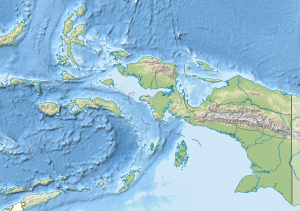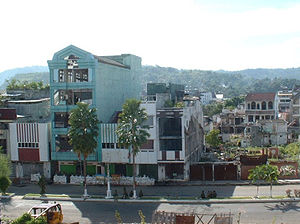Ambon (island)
| Ambon | ||
|---|---|---|
| Ambon (to the west) and the Lease Islands | ||
| Waters | Banda Lake | |
| Archipelago | Moluccas | |
| Geographical location | 3 ° 40 ′ S , 128 ° 10 ′ E | |
|
|
||
| length | 51 km | |
| surface | 775 km² | |
| Highest elevation |
Salahutu 1038 m |
|
| Residents | 441.613 (2010) 570 inhabitants / km² |
|
| main place | Ambon | |
| Capital Ambon 2001 | ||
Ambon is a 775 km² Indonesian island in the Moluccas . It belongs to the Maluku Province . The 270,000 inhabitants of the provincial capital Ambon are predominantly Christians. The city has an airport and two universities.
The 51 km long island is part of an island chain and is located in the northern Banda Sea , in the south of the comparatively larger neighboring island of Seram . The highest mountains, the Salahutu at 1,038 meters and the Wawani at 903 meters, are of volcanic origin and have hot springs . The rock consists mainly of granite and serpentine rocks . In the past, parts of the island were shaped by tropical rainforests. Today Ambon is only covered with secondary vegetation. The island also includes the uninhabited islands of Nusa Ela , Nusa Hatala , Nusa Lain and Nusa Pumbo .
history
The Portuguese visited Ambon as the first European nation in 1511. In 1599 they were able to repel a siege by the Dutch , but in 1609 the Dutch East India Company prevailed and drove the Portuguese out. The English set up a settlement near Cambello in 1615, but had to give it up in 1623 after an attack by Dutch troops who destroyed the settlement. After losing the First Anglo-Dutch War in 1654, Oliver Cromwell forced the Dutch to pay compensation for the descendants of those who survived the attack.
The poet John Dryden wrote in 1673 in the tragedy Amboyna, or the Cruelties of the Dutch to the English Merchants of the events of the Amboyna massacre in 1623. England occupied Ambon in 1796 under Admiral Rainier, and in 1802 returned the island to Dutch administration. From 1810 to 1814 there was a renewed occupation by the English. Ambon was the worldwide center of clove production until the 19th century. In order to maintain the monopoly, the Dutch issued a ban on growing the plant on other islands under their rule. During the Dutch rule , the island's capital Ambon was the administrative seat and military center of all colonies in the Moluccas.
The city protected Fort Victoria . The residents were divided into two classes, the orang burger for the townspeople and the orang negri for the rural people.
During the Second World War , the island was assigned to the ABDACOM shelter . Japanese units captured Ambon at the Battle of Ambon in the spring of 1942.
After the Allied victory over Japan, Indonesia proclaimed its independence in 1945. The Christian population of the Moluccas proclaimed the Republic of Maluku Selatan in 1950 after unrest , after which Indonesian troops occupied the capital in November. Since then there have been considerable riots, which have also left their mark in the Netherlands. On March 13, 1978, extremist members of the Ambonese living on the Moluccas attacked the building of the provincial government in Assen and took 70 people hostage. In an ultimatum, they demanded the release of 21 South Moluccan prisoners as well as a bus and plane to leave the country. Dutch elite soldiers liberated the people the next day. A hostage died a short time later from the wounds suffered during the rescue operation. The Ambonese who were involved in the crime were sentenced to 15 years in prison.
Web links
Individual evidence
- ↑ Population of Indonesia by Village 2010 ( Memento from April 6, 2013 in the Internet Archive ) (PDF; 5.9 MB) by Banda Pusat Statistics. The value results from the addition of the number of inhabitants for the districts Nusaniwe, Sirimau, Teluk Ambon, Baguala, Leitimur Selatan, Salahutu, Leihitu and Leihitu Barat (pages 1962, 1977, 1978)
- ↑ Chronologie de l'histoire du Timor (1512–1945) suivie des événements récents (1975–1999) (French; PDF; 887 kB)




